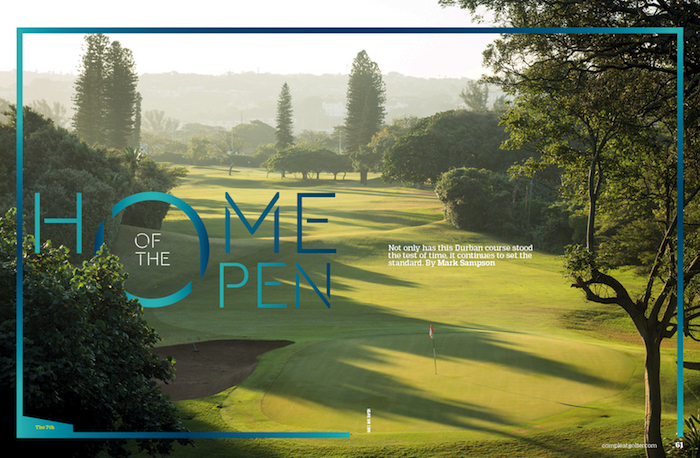Durban Country Club has a rich pedigree few South African courses can rival, writes MARK SAMPSON in Compleat Golfer.
The massive Cape Dutch clubhouse alludes to its history and reputation as a ‘must-play’ course. The corridors are adorned with historical photographs, trophies, architectural drawings and portraits of illustrious members of yesteryear, and are well worth a visit before heading out onto the fairways.
It is essentially a well-oiled country club with facilities that include a swimming pool, bowling green and tennis and squash courts. The strong membership is due not only to the facilities, but also the five-star service that’s always on offer.
The club’s proximity to the ocean and the Durban CBD is appealing to the travelling golfer. In the early part of the 20th century, the only course in the area was Durban Golf Club, which is now Royal Durban, inside Greyville Racecourse. But, being in the swamp area, it was prone to flooding, which in 1920 almost caused the cancellation of the SA Open, an event which was described afterwards as a ‘slop-fest’.
The Durban authorities, concerned that the city would never be invited to hold a major tournament again, decided to build a course on higher ground. After much research, the dunes overlooking Blue Lagoon estuary and the Indian Ocean were chosen. The undertaking was vast, bearing in mind the lack of machinery; with thick coastal bush and sand dunes having to be removed manually by legions of labourers and sculpted into what is now one of South Africa’s best layouts.
The man responsible for the first layout was George Waterman, a Scottish professional golfer who was assisted by local golf professional Laurie Waters, a four-time winner of the South African Open. The official opening of the course was in December 1922, and the new club members were so delighted that they named a trophy after its architect,
the Waterman Cup.
Like most courses of its age, it has had a number of nips and tucks over the years, the first of which was in 1928 at the hands of well-known course architect Colonel SV Hotchkin, also responsible for courses like Humewood and East London. Later, another well-known designer, Bob Grimsdell, architect of numerous layouts in South Africa like Wanderers, St Francis Bay and Clovelly, reworked the layout, which was completed in 1959. The course has had continuous alterations, with input from Gary Player and Peter Matkovich, and in 2010 the greens were relaid.
In 2011 the management embarked on a programme of restoring the shape of the fairways to the original layout and on reducing the encroaching vegetation. It was prompted in part by the members’ complaints that the tightness of the fairways was excessive, particularly when the wind was up.
Essentially the course, measuring 5 910m from the club tees, is on a thin tract of land along the coast, etched out of thick bush with many changes in elevation. Located so close to the ocean, wind is always in play and the fairways are studded with mounds and swales. Accuracy is essential as the bush is unforgiving: staying in play should be the motto for the day.
Other than the stroke one mentioned in the signature hole on page 67, Durban Country Club has a number of memorable holes, with the short 12th the most notable. At 131m, it is an easy mid- to low-iron for most, but that does not mean you will safely find the surface. It has a long, narrow green which is extremely intimidating, having sheer 15-20m drop-offs on either side. A massive bunker directly in front of the green makes the target seem even smaller and when the wind is up it is a nerve-racking experience.
Edward, the Prince of Wales, and future King Edward VIII of England, took a 16 on the hole and, as recognition of his honesty in faithfully recording his score, the hole was named after him.
Another notable hole is the 8th, a decent par five at 440m guarded by massive mounds as you approach the green. A good drive will leave you with the option of going for the green or laying up. From 80m out, the swales can completely obscure the green, making for an interesting approach.
The closing holes are also memorable. The 16th is a par-four dogleg right with a bunker on the left corner, directly in line with the tee. Thick bush runs from tee to green and any wayward shots will require a reload. A drive short of the bunker will leave 120m to the elevated green, protected by three bunkers.
The 17th has similar DNA to the 8th, with its fairway rising to the green, pockmarked with crests and troughs. The fairway has no real landing area as it slopes from right to left, and the ball will undoubtedly find a low-lying area. Getting your yardage right, inclusive of the change in elevation, and trusting the club are very much part of playing this grand dame of a course.
The closing hole is a drivable par four responsible for the loss of many a tournament and bragging rights at the 19th. At 241m it’s reachable, but the fairway has a steep left-to-right slope which continues down to the driving range 20-odd metres below. The green is surrounded by bunkers, which makes it a tough target. All in all, it is a great finishing hole enticing the longer hitters to finish with a birdie; in theory, of course.
The course has lured the best in the business, including Sid Brews, Bobby Locke and John Bland. The quality of
its demanding layout is confirmed by the numerous tournaments played on its hallowed fairways. There have been 17 South African Opens hosted, as well as the Volvo Golf Championships in 2013 and 2014. Past winners include Gary Player and Ernie Els, who won the centennial SA Open in 2010.
Although set near the city and in a semi-commercial area with the Moses Mabhida Stadium casting a shadow on the clubhouse, the course is home to ample wildlife: it is a micro-sanctuary. Dwarf mongooses are common and can be seen foraging in large numbers. The birdlife is prolific and the club offers bird watching as a member activity.
As a venue, in general, it also offers several extra facilities, including a number of bars, restaurants and conference facilities. The patio outside the bar boasts one of the best views overlooking the Indian Ocean. Durban Country Club is a course every golfer needs to visit; with its long history, unique layout and five-star facilities, it oozes class.
DURBAN COUNTRY CLUB
CONTACT DETAILS
(031) 313 1777; [email protected]
WEBSITE
durbancountryclub.co.za








